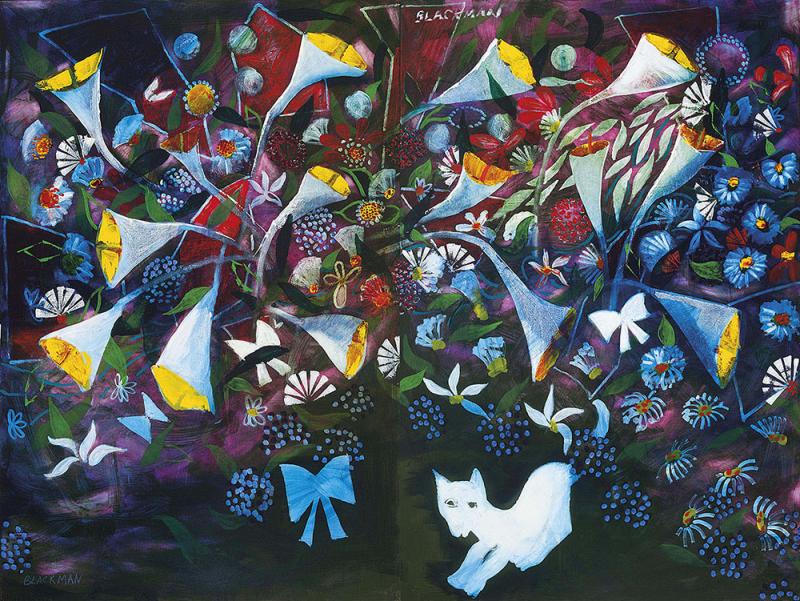CHARLES BLACKMAN born 1928
Alice in the Cat's Garden c1969
Estimate: $140000 - 160000
Sold For:
$115,000 hammer
Description
CHARLES BLACKMAN born 1928
Alice in the Cat's Garden c1969
oil on canvas (diptych)
183.0 x 122.0 cm (each panel)
left panel signed lower left: BLACKMAN
right panel signed upper left: BLACKMAN
right panel inscribed with artist's dedication verso
Provenance:
Gift from the artist, private collection, Queensland
Private collection, Sydney
Related Works:
Garden of Lures, c1969, oil and acrylic on canvas, 170.0 x 240.0 cm, illus. in Amadio, N., Charles Blackman The Lost Domains, A. H. & A. W. Reed Pty Ltd, Sydney, 1980, no. 6.2, pp. 82, 143 (illus. p.82)
Estimate: $140000 - 160000
Result Hammer: $115,000
Born in 1928, Charles Blackman has long been regarded as one of the most original and significant figurative painters in Australian art. From his critically acclaimed Schoolgirl series, which single-handedly heralded his triumphant arrival on the art scene in the 1950s, to the equally successful subsequent Alice in Wonderland, Garden and Cat in the Garden series, Blackman’s work has been profoundly personal.
With the steadily deteriorating eyesight of his wife Barbara, Blackman would become her eyes, often reading poetry or philosophy for her. Occasionally they would listen to talking ‘Books for the Blind’ together. One such talking book, read by Alvar Liddell of the BBC, was Lewis Carroll’s, Alice in Wonderland, which was to provide the genesis for Blackman’s next series of hauntingly beautiful work.1 Blackman’s Alice in Wonderland series delved far beyond the title he appropriated, exploring Barbara’s pregnancy and blindness in a fascinating fusion with Carroll’s chaotic tea parties and other irrational circumstances, usually accompanied by the white rabbit and a bountiful floral bouquet.
From the Alice in Wonderland series, it was a straightforward transition to the Garden series, which evolved into the charming Cat in the Garden series. While each series is quite distinct, traces of this evolution are imbued in the fantastical tone of the diptych on offer. The joyful and exuberant flowers, notably without any sense of impending decay, represent creation and the Garden of Eden, and are a metaphor for life, while also hinting at a more directly personal raison d’être. Indeed Blackman’s biographer suggested the garden is ‘the domain he lost some time in his childhood and has been painting his way back to ever since. The garden images stem from many sources, real, remembered and imagined. They are not just gardens. They are flowers encircling a feeling or a secret atmosphere. In these quiet dramas with their luminosities of colour and their tender rhythms, his gardens have the medieval power of illuminated stained glass.’2
Works from the Cat in the Garden series possess a lyrical quality, as if Blackman is evoking a dream-like state. Blackman claimed, ‘I was trying deliberately to create a sense of unreality, of it being the cat’s garden with no human being in it. A world shut off from everything else. It’s funny, while I was working on it, my daughter… started reading me a story about a cat stepping into a wardrobe and out into his own garden... I don’t say I’m psychic or anything, but the two did coincide.’3
Blackman unwittingly found inspiration for the series in the creation of a new studio space. In 1967, friend and builder Halifax Hayes utilised the roof of Blackman’s house to create a large studio that overlooked a neighbour’s garden frequented by the family’s white cat. The cat ‘is a symbol of many things; innocence, childhood, a familiar, a night-self visiting secret places – the enchanted gardens of memory.’4 Meanwhile on an aesthetic level, the series was initially informed by impressionist Claude Monet’s late Japonisme inspired water lilies, with their flattened space and distinctive lack of three-dimensional form. The resulting Cat in the Garden series represents yet another exemplary chapter within Blackman’s oeuvre and his extraordinary contribution to Australian art.
Footnotes
1. Gleeson, J., James Gleeson interviews: Charles Blackman, 26 April 1979, http://nga.gov.au/Research/Gleeson/pdf/Blackman.pdf (visited 22/9/13)
2. Amadio, N., Charles Blackman: The Lost Domains, A.H. & A.W. Reed, Sydney, 1980, p.80
3. Hall, S., ‘Blackman: Ten years after the Antipodean affair’, Bulletin, 5 July 1969, p. 32
4. Amadio, N., op.cit., p.80
Marina Brennan, BA (Hons)
Location
SYDNEY VIEWING. 17 - 20 October 11am - 6pm. 12 Todman Avenue, Kensington
MELBOURNE VIEWING. 24 - 30 October 11am - 6pm. Stonnington Mansion, 336 Glenferrie Rd, Malvern
